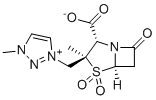
AAI-101
CAS No. 1001404-83-6
AAI-101( AAI 101 | AAI101 )
Catalog No. M10015 CAS No. 1001404-83-6
AAI-101 is a novel extended-spectrum β-lactamase inhibitor with activity against many β-lactamases, including some class A and class D carbapenemases.
Purity : >98% (HPLC)
 COA
COA
 Datasheet
Datasheet
 HNMR
HNMR
 HPLC
HPLC
 MSDS
MSDS
 Handing Instructions
Handing Instructions
| Size | Price / USD | Stock | Quantity |
| 2MG | 41 | In Stock |


|
| 5MG | 67 | In Stock |


|
| 10MG | 112 | In Stock |


|
| 50MG | 337 | In Stock |


|
| 100MG | 483 | In Stock |


|
| 200MG | Get Quote | In Stock |


|
| 500MG | Get Quote | In Stock |


|
| 1G | Get Quote | In Stock |


|
Biological Information
-
Product NameAAI-101
-
NoteResearch use only, not for human use.
-
Brief DescriptionAAI-101 is a novel extended-spectrum β-lactamase inhibitor with activity against many β-lactamases, including some class A and class D carbapenemases.
-
DescriptionAAI-101 is a novel extended-spectrum β-lactamase inhibitor with activity against many β-lactamases, including some class A and class D carbapenemases; is currently in clinical development as a combination with cefepime, reduces the MIC50 of cefepime against a collection of 223 cefepime-nonsusceptible isolates of the family Enterobacteriaceae from >64 mg/L to 0.125 mg/L.Bacterial Infection Phase 1 Clinical(In Vitro):Enmetazobactam shows potent activity against specific resistance phenotypes with MIC50 and MIC90 of 0.125 mg/L and 64 mg/L. Cefepime-Enmetazobactam MICs decreases with increasing concentrations of Enmetazobactam (over the range from 1 to 16 mg/L) for most strains, demonstrating a concentration dependence of Enmetazobactam on restoration of the antibacterial activity of the cephalosporin. (In Vivo):In neutropenic animals, cefepime-Enmetazobactam treatment results in reductions in bacterial density of ≥0.5 log10 CFU for 12 of the 20 strains tested and reductions of ≥1 log10 CFU for 6 of these. Increases in bacterial density are for only four strains, three of which have cefepime-Enmetazobactam MICs of ≥64 mg/L, irrespective of the Enmetazobactam concentration.
-
In VitroEnmetazobactam shows potent activity against specific resistance phenotypes with MIC50 and MIC90 of 0.125 mg/L and 64 mg/L. Cefepime-Enmetazobactam MICs decreases with increasing concentrations of Enmetazobactam (over the range from 1 to 16 mg/L) for most strains, demonstrating a concentration dependence of Enmetazobactam on restoration of the antibacterial activity of the cephalosporin.
-
In VivoIn neutropenic animals, cefepime-Enmetazobactam treatment results in reductions in bacterial density of ≥0.5 log10 CFU for 12 of the 20 strains tested and reductions of ≥1 log10 CFU for 6 of these. Increases in bacterial density are for only four strains, three of which have cefepime-Enmetazobactam MICs of ≥64 mg/L, irrespective of the Enmetazobactam concentration.
-
SynonymsAAI 101 | AAI101
-
PathwayGPCR/G Protein
-
TargetAntibacterial
-
RecptorAntibacterial
-
Research AreaInfection
-
IndicationBacterial Infection
Chemical Information
-
CAS Number1001404-83-6
-
Formula Weight314.32
-
Molecular FormulaC11H14N4O5S
-
Purity>98% (HPLC)
-
SolubilityDMSO : ≥ 113.3 mg/mL 360.46 mM
-
SMILESC[N+]1=NN(C[C@@](S([C@]2([H])C3)(=O)=O)(C)[C@H](C([O-])=O)N2C3=O)C=C1
-
Chemical Name(2S,3S,5R)-3-methyl-3-((1-methyl-1H-1,2,3-triazol-3-ium-3-yl)methyl)-7-oxo-4-thia-1-azabicyclo[3.2.0]heptane-2-carboxylate 4,4-dioxide
Shipping & Storage Information
-
Storage(-20℃)
-
ShippingWith Ice Pack
-
Stability≥ 2 years
Reference
1. Crandon JL, et al. Antimicrob Agents Chemother. 2015 May;59(5):2688-94.
2. Crandon JL, et al. Pathogens. 2015 Aug 18;4(3):620-5.
molnova catalog



related products
-
Pefloxacin
Pefloxacin is a an antibacterial agent and prevents bacterial Dna replication by inhibiting Dna gyrase (topoisomerse) .
-
L-161240
L-161240 is an antimicrobial agent associated with lipid A biosynthesis with an IC50 value of 30 nM as determined by DEACET and a MIC value of 1-3 μg/ mL against wild-type E. coli.
-
6-Diazo-5-oxo-L-nor-...
L-6-Diazo-5-oxonorleucine is an antagonist of glutaminases (Ki : 6 μM). It is an antineoplastic antibiotic produced by an unidentified species of Streptomyces from Peruvian soil.



 Cart
Cart
 sales@molnova.com
sales@molnova.com


